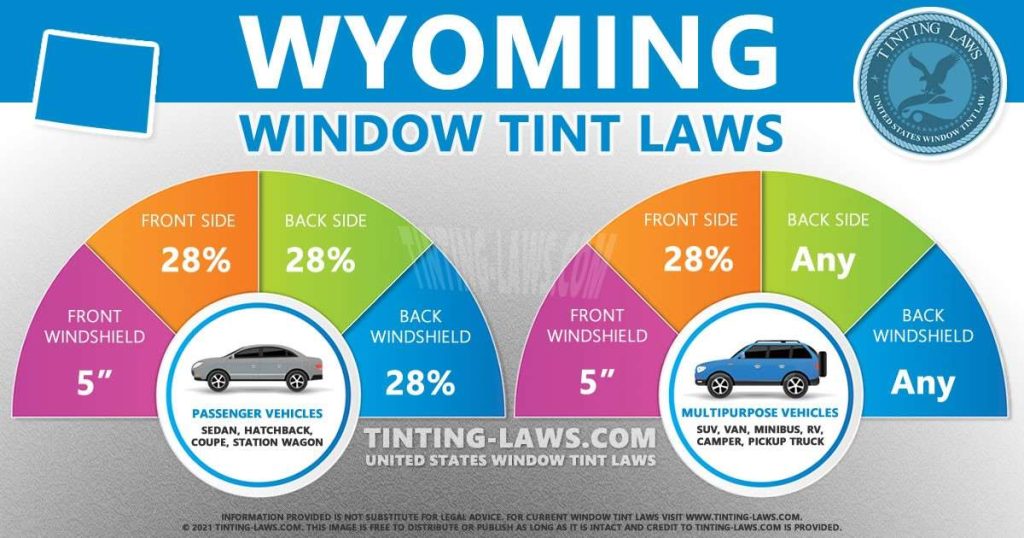Wyoming Window Tinting Laws
Car window tinting laws in Wyoming were enacted in 1996.
We have provided all the necessary information about your car’s window tint, including how dark or reflective the tint is allowed in your state.
There are also additional car window tinting rules and regulations in Wyoming so make sure you read all about it below.
Window tint darkness in Wyoming
The percent of visible light allowed through your car windows is called VLT: Visible Light Transmission.
The percentage of light allowed through your film and glass in Wyoming is very specific and different for sedan cars and SUV cars or vans.
Tint darkness for sedans:
- Windshield: Non-reflective tint is allowed above the manufacturer’s AS-1 line or top 5 inches.
- Front Side windows: Must allow more than 28% of light in.
- Back Side windows: Must allow more than 28% of light in.
- Rear Window: Must allow more than 28% of light in.
Tint darkness for SUV and vans:
- Windshield: Non-reflective tint is allowed above the manufacturer’s AS-1 line or top 5 inches.
- Front Side windows: Must allow more than 28% of light in.
- Back Side windows: Any darkness can be used.
- Rear Window: Any darkness can be used.
Window tint reflection in Wyoming
Window tint can reflect incoming light and reduce glare and heat.
Wyoming window tint law permits a certain window reflection when using a tint so make sure you pay attention to this as well.
Tint reflection for sedans:
- Front Side windows: Must not be more than 20% reflective.
- Back Side windows: Must not be more than 20% reflective.
Tint reflection for SUV and vans:
- Front Side windows: Must not be more than 20% reflective.
- Back Side windows: Must not be more than 20% reflective.
Other Wyoming window tint rules and regulations:
Wyoming does have several other important laws, rules and regulations pertaining to window tinting. They include the following:
- Side Mirrors: Dual side mirrors are required in Wyoming if any window behind driver is tinted.
- Restricted Colors: No red, yellow or amber on windshield. No color restrictions for other windows.
- Certificates: Film manufacturers don’t need to certify the film they sell in this state.
- Stickers: No sticker to identify legal tinting is required by law.
- Medical Exceptions: Wyoming tint laws allow medical exemptions for darker tint.
Keep in mind that Wyoming tinting laws and regulations may be interpreted differently in your county or place of residence.
We always recommend double-checking our information with your local DMV or law enforcement authorities.

State of Wyoming Info
Wyoming is a state in the mountain region of the Western United States: 10th most extensive, but the least populous and the second least densely populated of the 50 United States.
The western two thirds of the state is covered mostly with the mountain ranges and rangelands in the foothills of the Eastern Rocky Mountains, while the eastern third of the state is high elevation prairie known as the High Plains.

Cheyenne is the capital and the most populous city of Wyoming with a population of nearly 60,000 people within its city proper.
Capital: Cheyenne
Population: 578,803
Area: 97,814 sq mi (253,348 km2)
Cities in Wyoming: Cheyenne, Casper, Laramie, Jackson, Cody, Gillette, Rock Springs, Sheridan, Lander, Riverton, Thermopolis, Rawlins, Pinedale, Evanston, Green River, Pavillion, Buffalo, Buford, Worland, Douglas, Spearfish, Sundance, Powell, Torrington, Kemmerer, Dubois, Saratoga, Wheatland, Lost Springs, Afton, Ten Sleep, Elk Mountain, Lusk, Greybull, Basin, Medicine Bow, Lovell, Newcastle, Big Piney, Fort Laramie, Glenrock, Willwood, Meeteetse, Alpine, Pine Bluffs, Goose Egg, Kaycee, Grand Encampment, Guernsey, Opal
Counties in Wyoming: Albany, Big Horn, Campbell, Carbon, Converse, Crook, Fremont, Goshen, Hot Springs, Johnson, Laramie, Lincoln, Natrona, Niobrara, Park, Platte, Sheridan, Sublette, Sweetwater, Teton, Uinta, Washakie, Weston